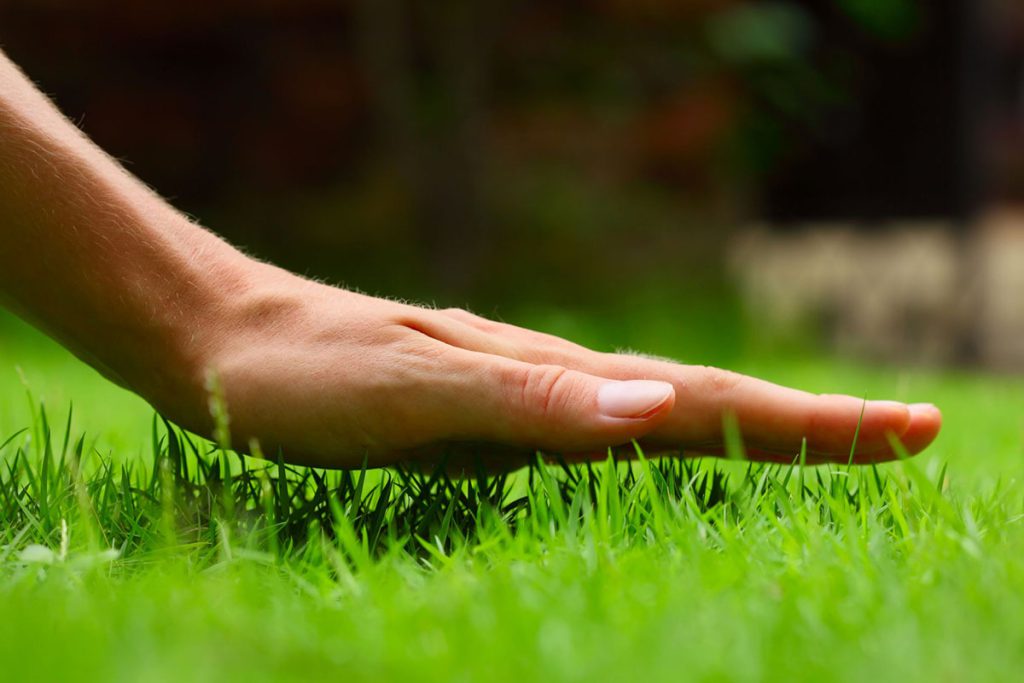Sep, 2023

Stimuler l’activité photosynthétique
How to stimulate photosynthetic activity?
Découvrir comment stimuler l’activité photosynthétique de vos végétaux pour un jardin en bonne santé.
La photosynthèse est le pilier de la vie végétale, c’est un processus grâce auquel les plantes transforment la lumière du soleil en énergie, tout en capturant le CO2 et en produisant l’oxygène (voir article Carbon offsetting).
Pour maintenir une pelouse saine peut parfois être un défi. L’une des clés pour obtenir un gazon en bonne santé réside dans la stimulation de son activité photosynthétique, le processus par lequel l’herbe transforme la lumière du soleil en énergie.
Proper watering and an eco-responsible attitude
L’eau est un élément crucial pour la photosynthèse, mais un excès ou un déficit d’eau peut freiner le processus. Assurez-vous de fournir à votre gazon une quantité d’eau adéquate, en prenant en compte des besoins de votre région selon les restrictions d’eaux obligatoire et du type de gazon que vous avez. L’arrosage tôt le matin ou en fin de journée est souvent recommandé pour minimiser l’évaporation.
Proper mowing
La hauteur de coupe du gazon est importante pour la photosynthèse. En général, il est conseillé de ne pas couper plus d’un tiers de la hauteur de l’herbe à chaque tonte. Laisser le gazon trop court peut réduire la surface des feuilles et entraver la photosynthèse.
Soil aeration
L’aération régulière du sol permet d’améliorer la circulation de l’air, l’infiltration de l’eau et la santé des racines, ce qui favorise la photosynthèse.

Weed control and disease prevention
Les mauvaises herbes et les maladies peuvent freiner la croissance de l’herbe. Utilisez des méthodes appropriées pour les contrôler et protéger ainsi la photosynthèse.
The sunlight
Assurez-vous que votre gazon reçoit suffisamment de lumière directe du soleil. L’herbe a besoin de lumière pour la photosynthèse, alors évitez les endroits excessivement ombragés.
To conclude
La stimulation de l’activité photosynthétique des plantes a le potentiel de révolutionner la façon d’entretenir son gazon en réduisant la demande en eau et en contribuant à la lutte contre le changement climatique. Il est donc essentiel de surveiller les conséquences potentielles de ces modifications sur les écosystèmes et de garantir ces avantages.
En comprenant les besoins de votre gazon et en mettant en pratique ces conseils, vous pouvez encourager une photosynthèse saine et aider votre pelouse à prospérer. Un gazon en bonne santé est non seulement agréable à l’œil, mais il contribue également à l’amélioration de la qualité de l’air, à la régulation de la température et à la préservation de l’écosystème local.
-
 For the garden
For the gardenVegetal Color: Green
Lawns|Boxwoods|Yerbs - 500ML | 1L | 4L | 10LNote 5.00 sur 5From 84.99€ View product This product has multiple variants. The options may be chosen on the product page -
 For the garden
For the gardenVegetal Color: Dark Green
Lawns|Hedges|Palm trees - 500ML | 1L | 4L | 10LNote 5.00 sur 5From 84.99€ View product This product has multiple variants. The options may be chosen on the product page

